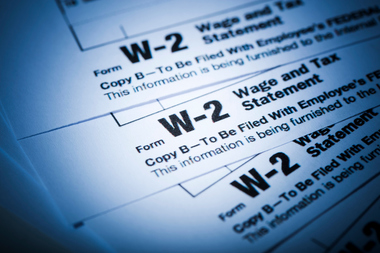
Form W-2: The Basics
 In many ways, Form W-2 is simple and straightforward: You enter information that is already available from payroll and personnel records. You then use your employer identification number and, in most cases, a state ID number to complete most of the form.
In many ways, Form W-2 is simple and straightforward: You enter information that is already available from payroll and personnel records. You then use your employer identification number and, in most cases, a state ID number to complete most of the form.
The main challenge comes when entering this data accurately into the fields on the form. It’s a good idea to double-check the boxes to make sure you haven’t entered the wrong figures or misspelled an employee’s name or address.
The W-2’s boxes
On the left side of the W-2 form are fields a through f; these boxes are where you enter basic identification for both the company and your employees: such items as names, addresses ID numbers.
Numerical fields 1 through 20 run in a double column on the right-hand side of the W-2 and continue along the bottom of the form. Wages and federal tax information are entered in the vertical columns. The bottom fields are where you enter state and local tax information. These horizontal boxes are divided by a dotted line; if the employee is working in more than one locality or state, the tier below the dotted line gives you the space you need to fill out withholdings for these additional places.
The W-2 also includes space to report deductions, such as contributions made to 401(k) and health savings accounts, money earned from tips, premiums paid by the employer for health or life insurance, deferred compensation, and money withheld for federal income tax purposes. Field 13 on the form includes checkboxes to indicate whether the employee doesn’t receive a regular paycheck (for example, because they work on commission), has received third-party sick pay (e.g., from an outside insurance company) or has been offered a retirement plan (which might limit their ability to invest in an individual IRA).
Note that the IRS periodically makes design changes to its forms, so you–and the software you use–may have to account for this.
What to do with W-2s
You are legally required to send copies of W-2s to the Social Security Administration and IRS, as well as most state and many local tax authorities. You must also provide each employee with three copies of their W-2. You always keep a copy for your records; be sure to retain it for at least four years.
All W-2 forms and copies must be mailed, or if your company generates more than 10 W-2s, sent electronically, to governments and employees by Jan. 31 of each year. If they are not mailed on time, you may face penalties.
Errors on a W-2 may be corrected by submitting a Form W-2c.
The IRS and the state compare income reported on tax returns to the information you send to the government in your company’s payroll reports.
If you fail to submit the W-2 forms to the IRS, the IRS can review your books and records. Penalties can range from $60 to $660, and can even reach $5,000.
IRS Publication 15, Employer’s Tax Guide, is an essential guide to filling out the W-2.
W-2 or W-4?
It is easy to confuse W-2s with W-4s. The W-4 is completed by an employee when starting a new job. The form tells you how much money to withhold from each paycheck so that the employee doesn’t owe too much tax at the end of each year. Employees can use the form at any time to request that more or less money be withheld.
Finally, keep in mind that this is just a general guide. The IRS may make changes from year to year, and a company may have a particular situation requiring special changes. Always work with a tax professional.



